“Hark!” he thinks. “A Poké Ball! I shall use it to catch a friend for my Rattata!”
He stoops to pick it up, and the next thing he knows… well, is actually nothing, because of the permanent burns and cellular damage, most likely to his heart and brain, the two organs most devastated by foreign electricity.
Trainer Joey
1998-2012
“He loved his shorts”
1998-2012
“He loved his shorts”
That’s right, folks: that was no Poké Ball, that was a Voltorb, and poor Joey is the victim of an uncaring corporation’s wanton tampering with the balance of nature.
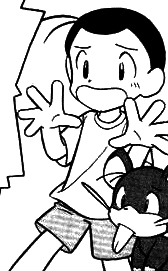
Wait, what?
The Critter
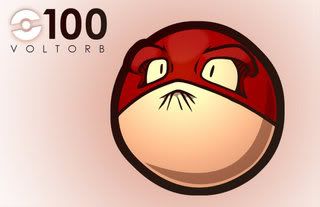
(Red/Blue Dex): Usually found in power plants. Easily mistaken for a Poké Ball, it has zapped many people.
(Ruby Dex): Voltorb was first sighted at a company that manufactures Poké Balls. The link between that sighting and the fact that this Pokémon looks very similar to a Poké Ball remains a mystery.
According to Bulbapedia, Silph Co and the Devon Corporation are the world’s leading manufacturers of Poké Balls, and from the descriptions it can be inferred the Silph designed the first mass-produced Poké Balls, and Devon has created further variations on the line (kind of like PCs and Macs). With that information, we’re going to focus on Silph Co as the creator of this trainer-nixing monstrosity.

YES, YOU, YOU MONSTERS.
The History
The first Voltorbs appeared around the same time that Poké Balls started being mass-produced. That means we should probably take a look at the history of Poké Balls; maybe it will give us a few clues.
The first functional Poké Balls were made of Apricorns, a practice that went on for hundreds of years. Apricorns are a special fruit that is native to the Johto region, differing from Berries in that an Apricorn's outer skin is far too tough for it to be eaten by a Pokémon. According to Bulbapedia, anywhere between 700 and 400 years before the events of the games, Apricorn Specialists were hollowing the things out and turning them into Pokémon capturing devices.

And they came in so many pretty colors.
They’d look at what’s being done already, and see how they could improve on it. The first problem would be acquiring the raw materials: Apricorns. Unfortunately, Apricorn trees are notoriously fragile, allowing only one to be collected a day lest the tree die. You could try and have a whole bunch of trees, but trees take up a lot of space, and the return on that space is only a single Apricorn a day. That’s just a bad investment. If only there was a way to breed hardier trees that could grow Apricorns faster… I know! We’ll fiddle with their genetics!
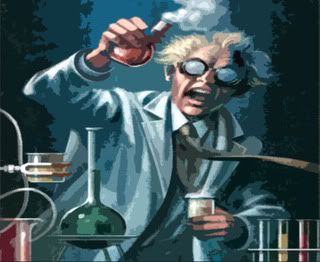
What could possibly go wrong?
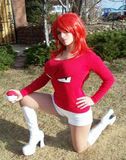
You COULD have made trees that grew hundreds of these, but nooooo.
Perhaps they injected it with Pokémon DNA just to see what would happen. It’s a heckuva leap, I know, but if Hollywood has taught me anything, it’s that when man starts messing around with stuff that nature’s spent millions of years perfecting, we’re pretty much engineering our own destruction.
They went in a different direction eventually, giving the world purely mechanical Poké Balls. Of course, as per usual when massive fortunes are on the line, this mishap was swept under the rug, but instead of destroying all the samples, somebody decided they’d keep one. “It’s kind of cute,” they might have thought, or maybe “I must study this phenomenon FOR SCIENCE!”
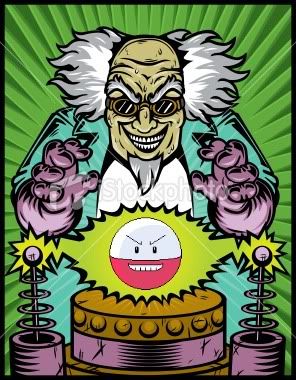
BWAHAHAHA!
It escaped. As with every living thing, it needed energy, but photosynthesis just doesn’t cut it for something that isn’t stuck in one place. If only there was some source of energy in massive quantitie- what’s that? A power plant?

You can’t tell me that doesn’t look delicious.
The rest is history. In my mind, they’re still a form of flora, growing on trees but capable of moving around on their own to find good places to grow.
As far as man-made genetic monstrosities go, Voltorb is no Mewtwo, but Mewtwo can at least be reasoned with: Voltorb is just a hungry animal, and like all hungry animals, it will lash out at anything that bothers it, including poor little kids that love Rattatas and shorts, and the likelihood of any confrontation ending well is slim to none.

Though, on the upside, you might get this really awesome scar.
So to fit into the Grand Poke War conspiracy...
ReplyDeleteSilph is owned by Americans who lobbied the government to give them the rights to the Pokeball-from-apricorns technology and set up shop in Japan. Or they're just out of copyright, which would explain why basic pokeballs are so cheap.
Maybe Voltorbs were produced to turn food into energy, because over-enthusiastic aid efforts and protections against an armed Japan have made food plentiful but energy scarce.